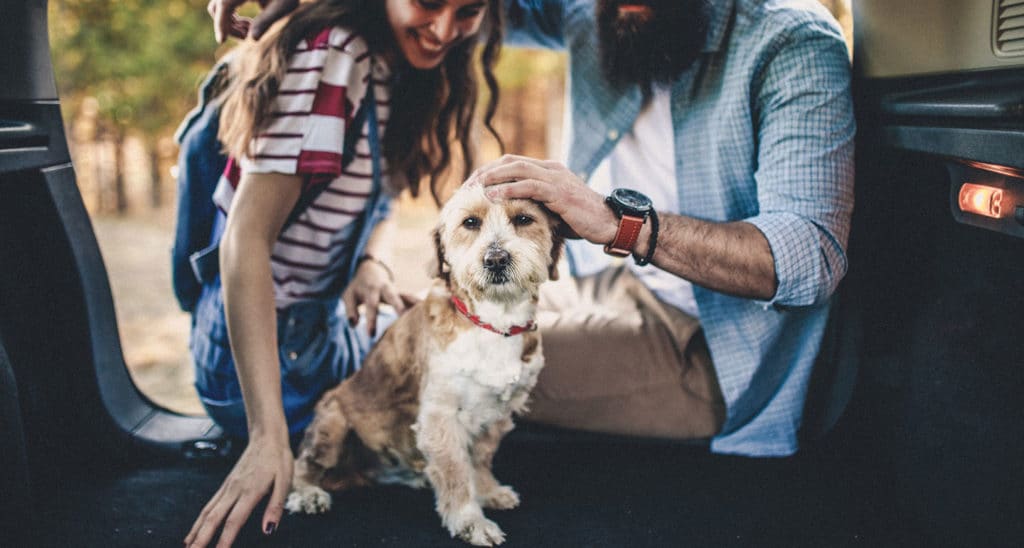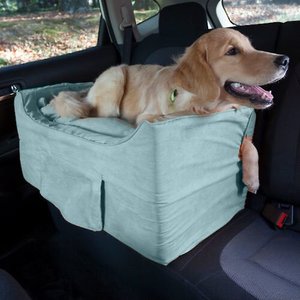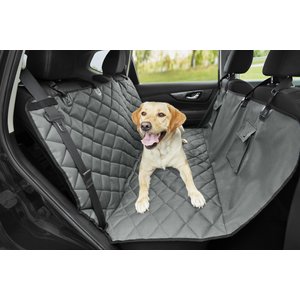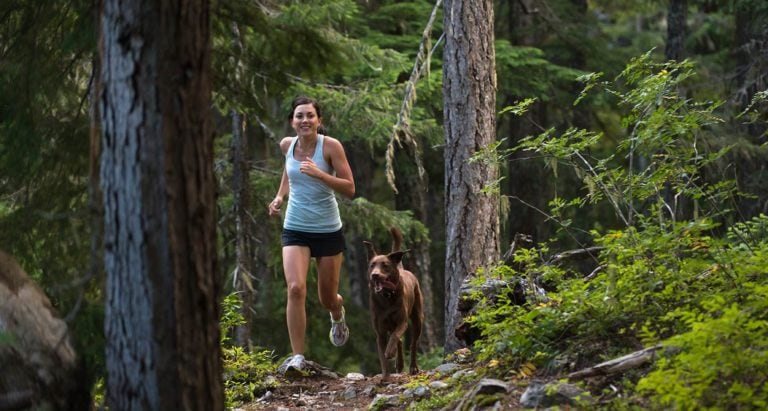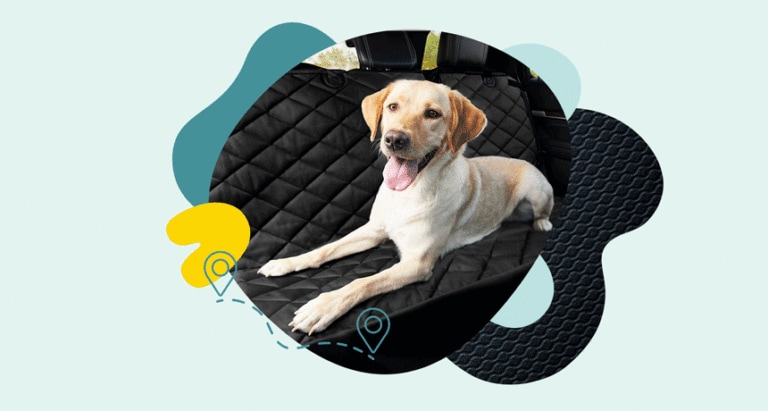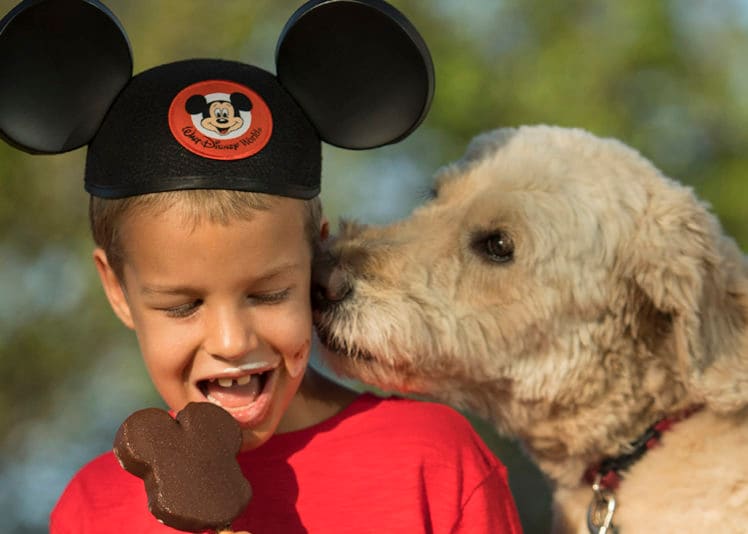Planes, trains and automobiles and … dogs! Increasingly, pet owners are taking their dogs along for the ride, whether it’s a short trip, a family visit or even an extended vacation. But do you know how to travel with a dog in the safest and most stress-free way?
About 45 percent of pet owners travel with their pets every year, mostly by car, up from 19 percent a decade ago, according to the 2019–2020 National Pet Owners Survey conducted by the American Pet Products Association (APPA). And while automobile remains the overwhelmingly preferred option, pet parents also travel by plane and train with their pets.
However, it’s not as simple as loading your dog up and taking to the sky, rails or roads.
Follow these tips for traveling with a dog by car, plane and train, and you’ll set both you and your pet up for a smooth ride.
Before You Go: General Tips for Traveling with a Dog
Whether traveling by car, plane or train, experts say it’s important to think about the welfare of your pet first and not just your own enjoyment.
Jennie Lane, RVT, ACAAB, certified animal behaviorist and owner of Synergy Animal Behavior in Germantown, Tennessee, says it’s important to decide “if the pet is healthy and is likely to enjoy the experience.”
“Pet owners should definitely have their pet examined by a veterinarian and discuss with the veterinarian whether or not the pet is prepared physically and mentally for the planned excursion,” she adds.
Factors to consider in your decision whether or not to take your pet on your travels include “where you are going, for how long, how you plan to spend your time, and who will look after your pet when she can’t be with you,” says Suzanne Hetts, Ph.D., and Daniel Estep, Ph.D., CAABs with Animal Behavior Associates Inc. in Sun City, Arizona. “Certainly, some trips with your pet can be great fun, but there are times when it might be best for Fido or Fluffy to stay at home.”
If you’ve decided to travel with your dog, socializing them and acclimating them to travel conditions is important, Lane says. Take pet carriers, for instance.
“The mistake many make is they only put an animal in a container when they’re going to the vet,” she explains. Instead, she says, pet parents should introduce positive experiences with the carrier, such as giving the pet treats or toys and making the space comforting and inviting.
No matter how you’re traveling, “Make sure you bring a familiar bed and toys along on a trip, along with any products related to your dog’s daily activities, such as a particular chew toy that the dog likes to chew before going to bed,” says Mary R. Burch, Ph.D., CAAB, CABC, BCBA-D, certified animal behaviorist in greater New York City area and director of the AKC Canine Good Citizen program. “A crate is essential to keep your dog safe and provide a familiar den for the dog.”
Now, let’s talk about the specific modes of transportation for traveling with your dog.
How to Travel With a Dog in a Car
One way to avoid paperwork, regulations, hassles and sidelong glances from fellow travelers is to pack up your own automobile and avoid commercial carriers.
According to the Automobile Association of America (AAA), “The first thing to consider [when road tripping with your dog] is how you are going to restrain your pet.”
While some pets may generally behave well, driving with an unrestrained dog can be unsafe not only for the driver, but the pet as well—and many drivers don’t know how to travel with a dog in a car without putting themselves or their furry friends at risk. According to a July 2011 AAA and Kurgo survey, 52 percent of respondents admitted to petting their dog while driving and 19 percent of respondents admitted to taking their hands off the wheel to restrain a dog. Such behaviors can distract the driver and increase the risk of a crash, according to the report.
There are many safer ways to drive with your dog. Some dogs have been trained to relax in carriers or kennels and find it the best way to travel. For some more nervous dogs, it may be a good idea to cover the crate with a blanket or cover to limit outside stimuli and distractions.
Make sure the carrier is safely secured. Otherwise it can become a projectile and dangerous to pet and traveler.
“Drivers should use a pet restraint system for your dog every time their pet is in the vehicle,” Jennifer Huebner-Davidson, AAA National, Traffic Safety Programs manager, told the AAA NewsRoom, adding, “an unrestrained 80-pound dog in a crash at only 30 mph will exert approximately 2,400 pounds of pressure. Imagine the devastation that can cause to your pet and anyone in its path.”
Some dogs ride well with a harness secured to a seat belt. Snoozer Pet Products’ Luxury Lookout dog and cat car seat is designed to calm pets with travel anxiety, giving them a soft, elevated perch while still restraining them with a connection strap that attaches the seat belt to the pet’s harness.
“There are also back seat bridges/extenders, seat covers, door protectors and seat fabric cleaners and deodorizers (for the inevitable accidents), to protect the inside of the car and make it more comfortable for the pet. Some may enjoy pet videos or soft music,” advises Hetts and Estep.
The Petego Car Seat Extender prevents pets from falling off the seat onto the floor, supporting dogs up to 165 pounds. Frisco’s Quilted Water-Resistant Hammock car seat cover also keeps pets from falling—while also protecting your auto upholstery from fur and scratches.
How to Travel With a Dog on a Plane
More than 2 million travelers fly with their pets in the United States each year, according to the U.S. Department of Transportation—not to mention the recent increase in emotional support animals on flights.
Federal guidelines require service animals and psychiatric or emotional support animals to be allowed on planes and fly for free, under provisions in the Air Carrier Access Act.
Pet dogs can also fly for a fee in-cabin or as cargo on all major domestic carriers. Each airline sets its own criteria for the pets in regard to size. Generally, they must fit inside a carrier stowed under a seat and must remain there.
Fees generally range from $75 to $125 for in-cabin dogs, and cargo rates vary. Southwest, Allegiant, Frontier, Jet Blue and Spirit Airlines do not allow animals as cargo.
Alice Moon-Fanelli, Ph.D., CAAB, certified animal behaviorist and owner of Animal Behavior Consultations LLC in Hartford, Connecticut, recommends against traveling with dogs as cargo, which she says is highly stressful, even for crate-trained dogs who can tolerate loud noises and location changes.
“I don’t know there’s a lot an owner can do to prepare a pet for that level of ‘over-stimulation assault,” she says.
In August 2019, the Department of Transportation (DOT) updated and clarified its guidance to airlines on service and emotional support animals. As the policy evolves, several airlines are changing their policies, so it is important to contact carriers for the latest.
Most airlines require documentation from physicians and/or veterinarians showing the need for animal support, current vaccinations and training. They must accept medical forms and letters that meet DOT criteria. The regulations give some latitude to carriers in the animals they will permit, but all dogs are allowed and airlines can no longer ban specific breeds as support animals.
Service and emotional support animals are defined by DOT as “individually trained or able to provide assistance to a person with a disability” or by providing emotional support to a person with a disability.
Some behaviorists, including Burch, are concerned about “owners misrepresenting their pet dogs as service or emotional support animals so they can fly with them. I certainly feel better when my dog is with me, but it’s simply unethical to abuse the system,” she says.
Many vets recommend against bringing brachycephalic, or flat-faced dogs such as Boxers, Bulldogs and Boston Terriers, on planes because of their sensitivity to pressure changes, recycled air and other environmental conditions. Some airlines limit the breeds of dogs they allow as cargo.
Although airlines cannot limit the number of service or support animals on a flight, they often limit the number of pet dogs allowed. If you plan to pay to bring along your dog as a pet, book early.
Also, it is important to talk with your travel provider about airport limitations and restrictions -- some don’t allow pet travel between certain dates as cargo temperatures may climb too high or low. Before you book, troubleshoot as many issues as you can in advance to reduce the potential for headaches en route.
If you are traveling internationally, be careful to check on added restrictions, including quarantines.
Check with individual carriers about pet policies: American Airlines, Delta Air Lines, Southwest Airlines, United Airlines, JetBlue, Alaska Airlines, Spirit Airlines, Frontier Airlines, Allegiant Air.
Read our complete guide to U.S. airlines pet policies.
Tips for Traveling With a Dog on a Train
When it comes to traveling with dogs by train, Amtrak is calling all aboard. Service animals, which Amtrak describes as “trained to perform a specific task for the benefit of a person with a disability,” are allowed on any train, and the number of dog-friendly routes for pet dogs has been growing steadily.
Service dogs travel for free. The fee for pets is $25 each way for trips less than 7 hours. One pet per passenger is allowed in coach class only. Pet dogs must weigh 20 pounds or less, including the carrier, which can be no more than 19-by-14-by-10.5 inches, and must be stowed under your seat. The carrier must be leakproof and waterproof with adequate ventilation.
Apart from Amtrak, more than 40 metro, regional and tourist trains and subways across the country allow small pets to ride as long as they are leashed or in carriers. If they are service animals, some train stations will require they wear some sort of identifying vest or special identification to indicate their status.
In most cases, no proof of vaccinations, health certificate, or any other paperwork is required, according to Million Mile Secrets’ train travel guide.
With proper planning and consideration for your pooch, traveling together can be a rewarding experience.
As Lane says, “Just like with many family members, people enjoy the company of someone they love.”
Read more:
Share:
